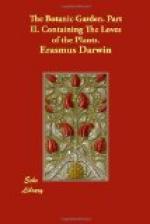And leads her gold-hair’d family of Loves.
These, from the flaming furnace, strong and bold
Pour the red steel into the sandy mould;
On tinkling anvils (with Vulcanian art),
160 Turn with hot tongs, and forge the dreadful dart;
The barbed head on whirling jaspers grind,
And dip the point in poison for the mind;
Each polish’d shaft with snow-white plumage wing,
Or strain the bow reluctant to its string.
165 Those on light pinion twine with busy hands,
Or stretch from bough to bough the flowery bands;
[The fragrant Gale. l. 151. The buds of the Myrica Gale possess an agreeable aromatic fragrance, and might be worth attending to as an article of the Materia Medica. Mr. Sparman suspects, that the green wax-like substance, with which at certain times of the year the berries of the Myrica cerifera, or candle-berry Myrtle, are covered, are deposited there by insects. It is used by the inhabitants for making candles, which he says burn rather better than those made of tallow. Voyage to the Cape, V. I. 345.]
Scare
the dark beetle, as he wheels on high,
Or
catch in silken nets the gilded fly;
Call
the young Zephyrs to their fragrant bowers,
170 And stay with kisses sweet the Vernal Hours.
Where,
as proud Maffon rises rude and bleak,
And
with mishapen turrets crests the Peak,
Old
Matlock gapes with marble jaws, beneath,
And
o’er fear’d Derwent bends his flinty teeth;
175 Deep in wide caves below the dangerous soil
Blue
sulphurs flame, imprison’d waters boil.
[Deep in wide caves. l. 175. The arguments which tend to shew that the warm springs of this country are produced from steam raised by deep subterraneous fires, and afterwards condensed between the strata of the mountains, appear to me much more conclusive, than the idea of their being warmed by chemical combinations near the surface of the earth: for, 1st, their heat has kept accurately the same perhaps for many centuries, certainly as long as we have been possessed of good thermometers; which cannot be well explained, without supposing that they are first in a boiling state. For as the heat of boiling water is 212, and that of the internal parts of the earth 48, it is easy to understand, that the steam raised from boiling water, after being condensed in some mountain, and passing from thence through a certain space of the cold earth, must be cooled always to a given degree; and it is probable the distance from the exit of the spring, to the place where the steam is condensed, might be guessed by the degree of its warmth.
2. In the dry summer of 1780, when all other springs were either dry or much diminished, those of Buxton and Matlock (as I was well informed on the spot), had suffered no diminution; which proves that the sources of these warm springs are at great depths below the surface of the earth.




